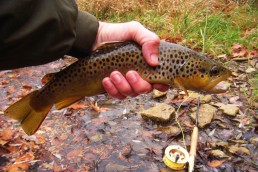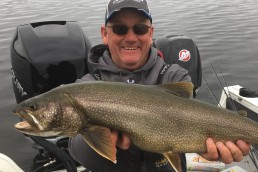Trout: Keep or Release? That is the Question
SHARE THIS POST
There are trout fishers who refuse to keep a trout, and there are others that think they must keep their limit. Then there are those who take even these ideas to extreme. Some put a dead trout in the water and count it as a release, while others will go out and catch their limit on one stream in the morning and catch another limit on another stream. This is illegal, but I know it is true from speaking to one fisherman on a stream one morning who told me he had limited out. Then in the afternoon, I saw that same person fishing on another stream. I had not limited out in the morning, but if he had been telling the truth, he was doing some illegal fishing.
The worst I have seen in the other direction was on a well-known trout stream. I already had two trout in my creel and was continuing to fish, releasing anything I caught. I was working my way downstream when I came upon a couple of fishers working their way upstream. I got out and went around them. I stepped back into the stream about 50 yards below them and continued to cast my spinners. After about five minutes, I heard a yell from one of those upstream and turned to look. One of the other men was swinging a nice-looking trout around like it was a real trophy. I did not pay any more attention to them until something hit me in my wader.
You may have already guessed, it was a nice 10-inch brookie.
It was floating belly-up and was obviously dead. I retrieved the trout from the stream and got out and went back up to where the other two were continuing to fish. When I got to them I asked if they had lost one of the trout they caught.
“No, we’re catch and release fishermen,” was the answer I got.
I asked if they knew it was dead, or at least if it was not dead when they released it that it would not live.
One of them laughed and said, “Can’t help that, we just catch and release. We don’t have time to clean fish, and besides, neither one of us eat fish.”
Are you enjoying this post?
You can be among the first to get the latest info on where to go, what to use and how to use it!
I asked them if they didn’t think that it was the waste of a good resource to throw away dead fish. And, as I was getting hot under the collar, I put the trout in my creel and that ended my fishing for that day.
Let’s look at the catch and release portion of this conversation. I am all for catch and release, to an extent. Trout Unlimited preaches catch and release trout fishing, but I do not believe that they mean “throwing back fish that will not live” as the two mentioned earlier did.
Taking a look at the proper way to practice catch and release is something all trout fishers should do. First, if you are going to fully practice catch and release, you need to use nothing but barbless hooks. One of the biggest mistakes that I see is that many are using standard barbed hooks. If you are a fly fisher and tie your own flies, start using nothing but barbless hooks. And if you purchase your flies you can make the hooks barbless. Take a pair of pliers and bend the barb down against the hook or file the barb off. I use a Dremel tool with a small grinding wheel attachment to eliminate the barbs. Those who use spinners that come with treble hooks should probably replace the treble hooks with a single barbless hook. I have done this with several spinners and find that it does not really change the action of the spinner. At the very least, you should make the treble hooks barbless, especially out on a stream where you may have kept trout for a meal and then have decided to stop before catching a limit and then going for catch and release.
If you want to make sure your release of the trout is done successfully, don’t even take them out of the water. Reach down into the water and take the hook out of its mouth and just it go. If you must take the trout out of the water, make sure the hand with which you hold it with is wet. When you put it in the water hold it loosely, facing it in an upstream direction. Then just take your hand away and let the fish go.
For the person who loves to eat trout, there are ways to have the best of both worlds. I love eating them, but I also want to leave the streams I fish with plenty of trout. Normally, I carry a couple of barbless lures with me so that when I get within one or two fish of my limit I can switch to them. Sometimes I wonder why I even bother to carry tackle with barbed hooks; I find very little difference in hooking and landing trout. Before I go out I decide how many fish I will keep. If I am on my own and will be fixing the trout for myself only, I will usually keep two trout. If I am going home and taking enough for my wife and myself, I will usually keep three. I do this so I can usually set my own slot limit. When fishing for brookies, I usually release any trout under 9 inches or any over 12.
Also, I normally fish streams where the DNR plants the trout. These are usually put-and-take streams where you are expected to keep your limit. I do not even think that bait fishers should be catch and release fishers. Too many trout will have the hook too far into their stomachs to be removed properly. The only thing you can do in that instance is to cut the line and let the fish go with the hook inside. The hook will eventually dissolve.
If you want to keep trout, or if you want to only practice catch and release, there is room for you on the trout stream. Whichever you decide, do your best to minimize damage to the trout population’s condition. We all love to fish trout, and if we all do our part there will continue to be plenty of trout for everyone. MWO
MWO
SHARE THIS POST
Did you enjoy this post?
You can be among the first to get the latest info on where to go, what to use and how to use it!



